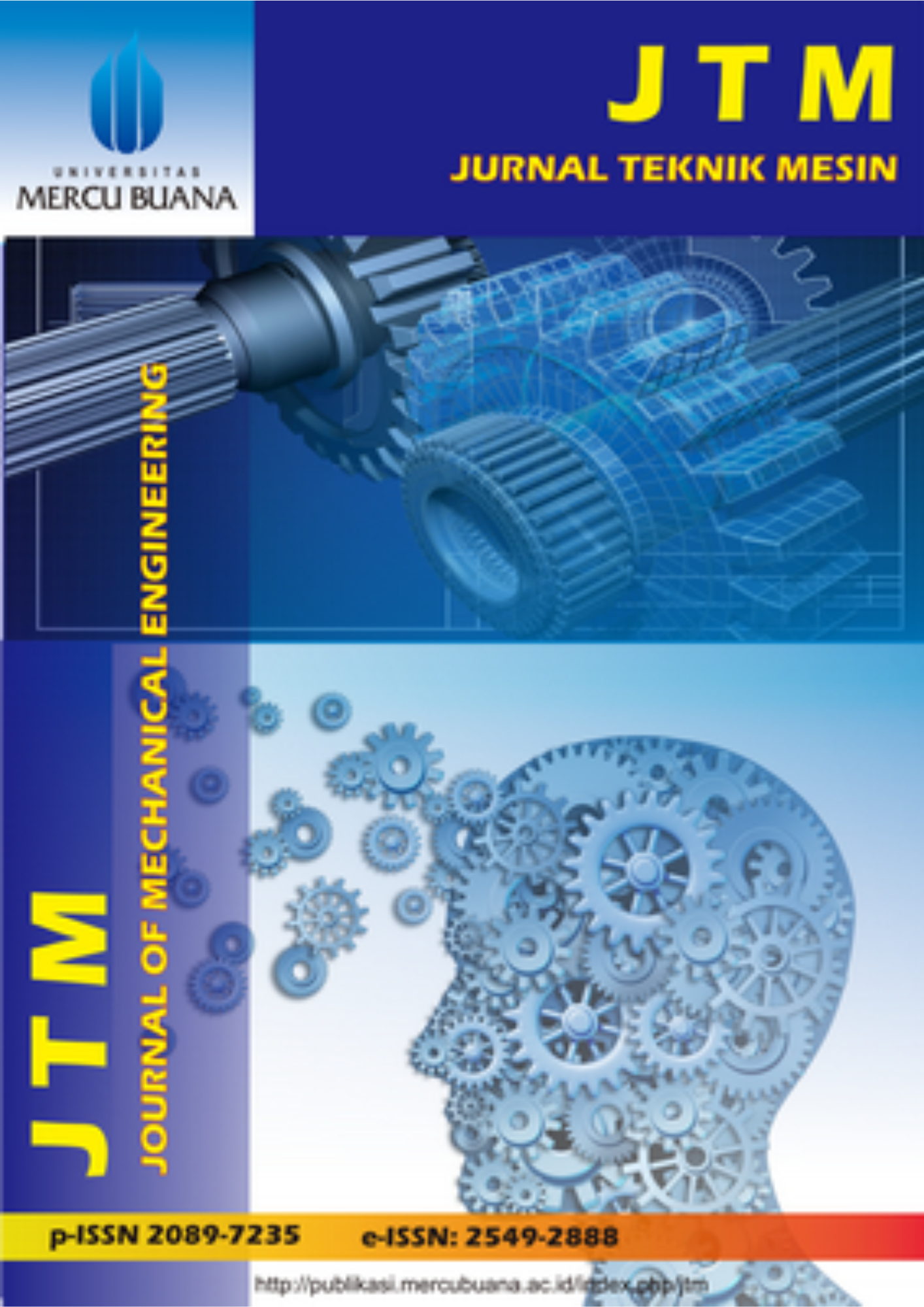FLEXURAL CHARACTERISTICS OF ROLL-WRAPPED GFRP COMPOSITE HOLLOW SQUARE TUBE
Abstract
Keywords
Full Text:
PDFReferences
Jafarzadeh H, Nematzadeh M. (2022). Flexural strengthening of fire-damaged GFRP-reinforced concrete beams using CFRP sheet: Experimental and analytical study. Compos Struct, 288: 115378. doi: 10.1016/J.COMPSTRUCT.2022.115378.
Huang L, et al. (2022). Dynamic splitting behaviour of ultra-high-performance concrete confined with carbon-fibre-reinforced polymer. Compos Struct, 284: 115155. doi: 10.1016/J.COMPSTRUCT.2021.115155.
Du Y, Gao D, Chen Z, Zheng Z, Wang X. (2022). Behaviors of FRP confined rectangular concrete-filled thin-walled steel tubular stub columns using high-strength materials under axial load. Compos Struct, 280: 114915. doi: 10.1016/J.COMPSTRUCT.2021.114915.
Gowid S, Mahdi E, Youssef S, Moustafa E, Mosleh A, Shokry A. (2021). Experimental investigation of the dynamic characteristics of wrapped and wound fiber and metal/fiber reinforced composite pipes. Compos Struct, 276: 114569. doi: 10.1016/J.COMPSTRUCT.2021.114569.
Shekar KC, Singaravel B, Deva Prasad S, Venkateshwarlu N. (2019). Effect of fiber orientation on the flexural properties of glass fiber reinforced, epoxy-matrix composite. Materials Science Forum, Trans Tech Publications Ltd, 969: 502–507. doi: 10.4028/www.scientific.net/MSF.969.502.
Xian G, Guo R, Li C. (2022). Combined effects of sustained bending loading, water immersion and fiber hybrid mode on the mechanical properties of carbon/glass fiber reinforced polymer composite. Compos Struct, 281: 115060. doi: 10.1016/J.COMPSTRUCT.2021.115060.
Chen D, Sun G, Jin X, Li Q. (2020). Quasi-static bending and transverse crushing behaviors for hat-shaped composite tubes made of CFRP, GFRP and their hybrid structures. Compos Struct, 239: 111842. doi: 10.1016/J.COMPSTRUCT.2019.111842.
Hatami AZ, Mulyo Bondan SR, Dzulfikar M. (2017). Pengaruh susunan tata letak serat pada komposit resin polyester-serat batang pisang terhadap kekuatan tarik.
Priyahapsara I, et al. (2017). Pengaruh variasi fraksi volume komposit serat E-glass ±45° polyester 157 BQTN terhadap kekuatan bending dan geser.
Putra FU, Paundra F, Muhyi A, Hakim F, Triawan L, Aziz A. (2021). Pengaruh variasi tekanan dan fraksi volume pada hybrid composite serat sabut kelapa dan serat bambu bermatriks resin polyester terhadap kekuatan tarik dan bending.
Paundra F, et al. (2022). Analisis kekuatan tarik komposit hybrid berpenguatan serat batang pisang kepok dan serat pinang. Journal Mechanical Engineering (NJME), 11(1).
Marlinawati NM, et al. (2021). Green composite pelepah pinang, pati singkong dan resin epoksi sebagai material ramah lingkungan.
Hariyanto A, AYani Tromol JI. (2021). Rekayasa dan manufaktur komposit sandwich hybrid untuk panel.
Widodo L, Priyanto K, Margono B. (2022). Analisis ketangguhan impak komposit polyester berpenguatan serat daun nanas berdasarkan jenis anyaman.
Sudarisman S, Haniel H, Taufik AK, Tiopan M, Himarosa RA, Muflikhun MA. (2023). Tensile, compressive, and flexural characterization of CFRP laminates related to water absorption. Journal of Composites Science, 7(5): 184. doi: 10.3390/jcs7050184.
DOI: http://dx.doi.org/10.22441/jtm.v14i2.33558
Refbacks
- There are currently no refbacks.
Copyright (c) 2025 Jurnal Teknik Mesin (Journal Of Mechanical Engineering)
Jurnal Teknik Mesin (JTM)
Program Studi Teknik Mesin, Fakultas Teknik, Universitas Mercu Buana
Jl. Meruya Selatan No. 01, Kembangan, Jakarta Barat 11650, Indonesia
Email: [email protected]
Telp.: 021-5840815/ 021-5840816 (Hunting)
Fax.: 021-5871335
JTM is indexed by the following abstracting and indexing services:

This work is licensed under a Creative Commons Attribution-NonCommercial 4.0 International License.






.png)







_(486_x_90_px)_(486_x_190_px)_(486_x_190_px)_(4).png)
_(486_x_90_px)_(486_x_190_px)_(486_x_190_px)_(5).png)
2.png)
.png)
